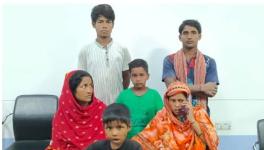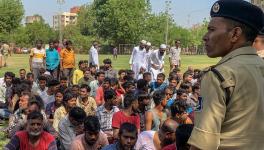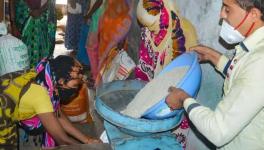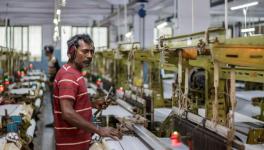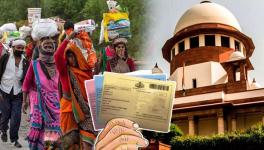Modi is Wrong: Death Data Shows Protest Not of Big Farmers—Economist Lakhwinder Singh
On 26 November 2020, waves upon waves of farmers descended upon India’s Capital. Barricaded from entering Delhi, they pitched tents at three border crossings on the outskirts of the city. They have resolutely stayed there since then, braving the wintry chill of last year, the scorching summer of this year, and overcoming their fear of the Covid-19 pandemic. They have cooked and eaten together. They have mourned those who died during the protest. They have nixed successive plans of the Union government to evict them. They have been, quite inspiringly, joined by women. They have braved police lathis, impressing all with their non-violent, or passive, resistance.
Intimidation was just one of the two deadly weapons in the Modi government’s arsenal. The other was to tarnish the image of protesting farmers. They were called Khalistanis. Nobody took that charge seriously. But, even more significantly, the Modi government, backed by experts and a segment of the media, crafted a narrative that the protest movement is mainly of, by and for big and prosperous farmers.
The Modi government’s narrative has been statistically proved false by Lakhwinder Singh and Baldev Singh Shergill. They collected data on the farmers who died while protesting. Believe it or not, they found that marginal and small farmers are those who constitute the dead.
Newsclick reached out to Lakhwinder Singh, Professor Emeritus, Department of Economics, Khalsa College, Patiala, to discuss the study he and Shergill undertook. Singh explains what their data suggest, the emergence of inter-class alliances in rural India, and why the protest movement has become a battle for their very survival.
In the joint study you and Baldev Singh Shergill undertook, “Separating Wheat from the Chaff: Farm Laws, Farmers’ Protest and Outcomes”, there is a rich vein of data on farmers who died during the ongoing protest movement. How did you all collect the data?
We have been following farmers’ protest ever since they began to amass on the outskirts of New Delhi on 26 November 2020. After a month or so, we read media reports on the death of some protestors. From these reports, we gathered the names of the deceased and the villages to which they belonged. We secured their telephone numbers, talked to their families, and gathered details such as their age and the size of their landholdings.
What was the distribution of death among the different categories of farmers?
We found that those who died during the protest movement owned and cultivated less than three acres of land. In India, small farmers are defined as those who own land between 2.47 acres and 4.97 acres. The dead largely comprised small farmers. However, when we also included those who were cultivating land taken on contracts, the average size of the landholdings of the dead went down to less than three acres.
This would mean that many among the dead were marginal farmers, who are defined as owning land less than 2.47 acres.
Yes. We counted 460 deaths between December 2020 and August 2021. Out of these deaths, 80% were marginal farmers. The remaining 20% were small farmers. [The death toll is now over 600.] I must point out that no woman farmer was reported dead until August 2021. However, since then, ten woman farmers, too, have died.
Does not your study give a lie to the claims of the Modi government and some experts that the protest movement is driven by big farmers, whose interests are said to be threatened by the three new farm laws?
It must be remembered that we have tracked only those who died while participating in the protest. We have not tracked the different categories of farmers who were and are participating in the protest.
However, it would be right to conclude that since only marginal and small farmers constitute the dead, they were, and are, represented in the protest in substantial numbers. To ascertain the precise proportion of their representation in the protest, you need to conduct sample surveys, which we did not do.
The dead do not lie. Since only marginal and small farmers died until August 2021, our study does give a lie to the claims of the Modi government and experts.
I suppose the Modi government will say small and marginal farmers are participating in the protest and dying because the false narrative of big farmers has hoodwinked them.
Those who say that are very condescending of the rural poor. It is as if they cannot understand what is detrimental to their interests. No doubt, farmer unions have played a significant role in educating them. But one defining characteristic of the movement is that it has attracted not only marginal and small farmers, but also their children and wives (women) and the landless labour. These groups have figured out that the three laws will lead to the corporates penetrating the agriculture sector.
They have seen agriculture become mechanised over the years. The corporate takeover of agriculture will further intensify mechanisation. Job opportunities will shrink or even disappear for most of them. Marginal and small farmers fear their land would be taken over by corporate giants through the contract farming system and their occupation will be snatched away. Their woes have been compounded because they have become heavily indebted over the years. This is why the entire village community is participating in the protest.
Is not this crisis also a consequence of the inability of the landless, the marginal and the small farmer to find jobs in urban India?
Post-liberalisation, a differentiation has taken place in the agrarian community. Over the last 30 years, some have shifted to other occupations and witnessed upward mobility. They are few in comparison to a much larger number of agriculturists who have seen their income dip. Their educational attainment is poor. They can no longer get jobs in the army, police or other government services [largely because the educated are competing for jobs.] On top of it, the quantum of government jobs has shrunk.
Would it be correct to say that the agrarian crisis has three aspects: declining income and downward mobility, indebtedness, and the inability to find jobs in the urban area?
Yes. We have done a fairly big study with a large data set on migrants moving from village to towns and cities of Punjab and Haryana. We found that the possibility of the migrants earning a higher income in the cities than in villages is very low. They, in fact, earned a meagre income. They did not witness upward mobility. This explains the crisis facing migrant labourers, a fact witnessed during the lockdown of 2020. This study will soon be published as a book.
Who are the people in villages who have witnessed upward mobility?
They are the people who acquired technical and medical education. There is a relationship between landholding size and education. The bigger the landholding a person has, the greater the chances of his children acquiring higher levels of education—and becoming upwardly mobility. The converse is as true.
Is it true that big farmers or their children, barring exceptions, have already shifted to other occupations and have little incentive to participate in the protest?
Yes, absolutely. They are, anyway, not in such large numbers that their participation could have turned the protest into a massive one.
Given the participation of marginal and small farmers in the protest, can we say that differences between agriculture classes have reduced?
Well, the rich have become richer in the post-liberalisation period. And the poor have become poorer. The middle peasantry, which comprises those owning land between five and 10 acres, is becoming poorer, not least because of the fragmentation of their land. They, too, have become heavily indebted over the last 30 years.
The terms of trade [or exchange of goods and services between rural and urban India] have gone against agriculture. YK Alagh, in his 2018 book, Economic Policy in a Liberalising Economy, calculated that since 1991, the rate of profit from agriculture has declined at the rate of 14% per annum.
Thus, the difference between those on the middle and lower rungs of the rural hierarchy is diminishing, as also the difference between the marginal and small farmer and the landless labourer.
In other words, the diverse agricultural classes are becoming equal not because they are getting wealthier but because of the general impoverishment.
Yes. But the impoverishment is not just because of the declining income from agriculture. In the post-liberalisation era, the impoverishment is also a result of people having to spend on healthcare and education, which were largely free before 1991 and of far better quality than today. Indeed, the privatisation of healthcare and education has increased the cost of living. An illness in a family in rural India leads to it being heavily indebted.
Is the diminishing difference between agricultural classes leading to a new class formation, which your study talks about?
Yes. Indeed, the current protest testifies to inter-class alliances. The middle, the small, the marginal peasantry, and the landless are coming together. Whether a person owns or does not own land matters little to the rural alliance that has been forged. Both the unions of farmers and the unions of the landless are participating in the protest movement.
Punjab’s marginal and small farmers feel that if the three laws are implemented [currently on hold because of a Supreme Court order], then they too, like those from Bihar, Madhya Pradesh and Uttar Pradesh, will have to leave their villages and find jobs in the cities of their state or, worse, even go outside the state.
Remember, many of the migrant labourers of Bihar are farmers back home but have to supplement their income by shifting to cities in other states. They even work as wage labourers on farms in Punjab. This fear of impoverishment and displacement are even more acute for Punjab’s landless, whose economic staying power is negligible. It makes them feel very vulnerable.
In that case, why are the three farm laws not being opposed in Bihar?
The issue here is: How do you educate the people? In the ongoing protest, the problems of marginal and small farmers are raised every day from the platforms of protesting farmers, especially the issue of indebtedness. Farmer leaders have demanded that debts should be waived. The protest is an outcome of farmer leaders mobilising people over the last five years to compel the state to take action to resolve the crisis facing them. The leaders are now telling farmers that the contract farming clause will dispossess them of their land. That is why they are up in arms. Protest is always incremental and is a function of how well the protestors are informed.
Did the emerging inter-class alliance lead to the formation, in 2017, of the All India Kisan Sangharsh Coordination Committee (AIKSCC), the umbrella group comprising 200 unions?
Yes. But this is also because of two other processes. Earlier, farmer unions would approach the Punjab government to voice their demands. It was only the state government that could address their problems. But now, when they approach the state government, they are told that the Central government is formulating policies and laws, as is certainly the case with the three farm laws, even though agriculture is a State subject. The AIKSCC, in fact, emerged because farmers want to wage their struggle at the national level, against policies being formulated by New Delhi.
Second, there is also consensus among political parties over economic policies, and assigning a far pivotal role to the corporate sector in India’s economy. Farmer leaders have understood that though political parties express their sympathies for their cause, they rarely build pressure on the party in power. Farmer unions have constituted the AIKSCC to scale up their protests, for which they have to pool their resources spread across different states.
Is the inter-class alliance bridging the caste divide?
Yes. As such, Punjab had anyway reduced untouchability and the differences and discrimination between different caste categories. Liberalisation has enhanced the problems of every segment of rural India. People can be mobilised for political action only by ignoring and, therefore, overcoming caste differences. The protest has given a boost to the communitarian idea of society and agrarian culture, which, in principle, is a composite one.
Who is looking after the families of the dead?
The Punjab government has a scheme to provide Rs. 5 lakh to the families of the dead. Whenever a person dies while protesting, farmer unions go to the Deputy Commissioner’s office and demand monetary compensation plus a job for a family member of the deceased. It is the farmer unions who are pursuing this. The Shiromani Gurdwara Prabandhak Committee also gives rupees one lakh to the family of the deceased. It is delivered immediately through the local gurdwara at the place where the deceased resided. There are also NGOs that have been carrying out surveys and assisting the families deprived of the breadwinner.
Farmer unions have been collecting funds. I do not think there is a household in rural Punjab that has not contributed money, be it Re. 1 or Rs 10. This has facilitated the mobilisation of the rural community, including the landless, to participate in the protest movement.
Your study also talks about farmers losing their political clout. How is that happening?
Among the purposes behind the enactment of the three laws is to reduce the role of farmers in electoral politics and policy-making. The farming community has not supported the BJP wholeheartedly. This is because the farming community is largely communitarian and its idea of religion does match that of the BJP.
The BJP also wants to pauperise the agrarian community so that its members shift from agriculture to other occupations, that is to say as daily wage workers in the corporate sector. The farmer movement has clearly brought out this facet of governance. Remember, for the first time, a protest movement spoke so vociferously and consistently against the Ambanis and the Adanis.
Will the farmer movement impact the forthcoming Punjab Assembly election?
Yes, definitely. The Akali Dal has been the traditional party of farmers. But today, they do not have the confidence of winning the elections. Their [past] support to the BJP is a big minus for them.
How do you see the future unfold?
The farmer movement has been spreading beyond Punjab, Haryana and west Uttar Pradesh. The ire of rural India is growing. For this reason, I think the political class will have to relent.
(Ajaz Ashraf is an independent journalist.)
Get the latest reports & analysis with people's perspective on Protests, movements & deep analytical videos, discussions of the current affairs in your Telegram app. Subscribe to NewsClick's Telegram channel & get Real-Time updates on stories, as they get published on our website.










